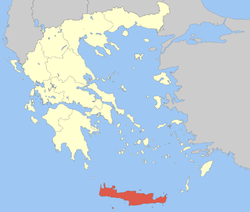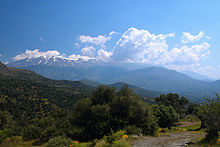Crete, Greece
|
Areas Page Editors: please follow the Guidelines, whether you are editing an in-game area or World Territory. |
On this page... (hide)
- 1. Description
- 2. Significance
- 3. Culture
- 4. References
Territory Statistics
| Status | REQUEST ? |
| Creator | Frost |
| Date of Founding | ~1988 |
| Primary Species | Canis lupus Familiaris |
| Luperci Dominant | Yes |
| Population | ~80 |
| Religion | Ancient Greek Theology |
1. Description
Crete is the largest island in Greece and the second largest in the eastern Mediterranean Sea (after Cyprus). It is located in the southern part of the Aegean Sea separating the Aegean from the Libyan Sea. Traders from Athens to Beirut and Cairo often stop off in the most populated (and port city) Heraklion to trade or relax before continuing across the Mediterranean.
The island has an elongated shape and is extremely mountainous. Its character is defined by a high mountain range crossing from west to east, formed by three different groups of mountains; The White Mountains, The Idi Range, and the The Dikti Mountains. These mountains lavished Crete with valleys, such as Amari valley, fertile plateaus, such as Lasithi plateau, Omalos and Nidha; caves, such as Diktaion and Idaion (the birthplace of the ancient Greek god Zeus); and a number of gorges.
Crete straddles two climatic zones, the Mediterranean and the North African, mainly falling within the former. As such, the climate in Crete is primarily temperate. The atmosphere can be quite humid, depending on the proximity to the sea, while winter is fairly mild. Snowfall is common on the mountains between November and May, but rare in the low lying areas. While mountain tops remain snow-capped year long, near the coast snow only stays on the ground for a few minutes or hours. However, a truly exceptional cold snap swept the island in February 2004, during which period the whole island was blanketed with snow. During the Cretan summer, average temperatures reach the high 20s-low 30s Celsius (mid 80s to mid 90s Fahrenheit), with maxima touching the upper 30s-mid 40s.
The south coast, including the Mesara Plain and Asterousia Mountains, falls in the North African climatic zone, and thus enjoys significantly more sunny days and high temperatures throughout the year. There, date palms bear fruit, and swallows remain year-round rather than migrate to Africa. The fertile region around Ierapetra, on the southeastern corner of the island, is renowned for its exceptional year-round agricultural production, with all kinds of summer vegetables and fruit produced in greenhouses throughout the winter.
2. Significance
This is the second largest Greek Canid settlement next to Athens, and the home of a couple prominent families.
3. Culture
The Cretan canines are a freedom-loving race, proud, independent, somewhat suspicious and even stubborn. Like Athens, Crete is highly civilized. The citizens are clearly defined in levels: high class (those canines who have status), low class (further divided into workers, merchants, etc.) and slaves (imported from African tribal states). Tools and humanesque tendencies are common throughout the ranks, and it should come as no surprise that Luperci genes dominate.
Interestingly, despite the obvious separation of class, Cretan canines interact with one another freely and without note of class constraint. Everyone, from the well-off to the weakest slave, participates in festive occasions, and no one is left out of the dancing. It is not uncommon to see a high class gentleman dancing with a slave girl, or vice versa. Equality and utopia are regards highly held among the freedom-driven Canids of Crete- though there are obvious differences in rank, even slaves are given several more degrees of freedom here than they might be elsewhere. With that in mind, Cretans like to party, so any Cretan canine is bound to be handy with music, dance, and drink.
3.1 Species
The native population of the genus Canis are predominantly Dog, with discreet Indian Wolf and Golden Jackal hybridization's up and down the lines. The whole of the island is Luperci.
Crete, an island remote enough to host unique species of animals, is home to a unique sub-species of wild goat, lynx, and other creatures, which also shaped the development of the local canid population. Ancient human breeding practices were ruthless and the limited means of the past taught them to neuter all but the best male dogs and destroy the dogs that were lacking in the hunt. As a result, many of the natives are strains of many, many years of this prior practice, yielding particularly strong and healthy breeds (for example, the Cretan Hound, bred in isolation on Crete for upwards of 3500 years prior to the extinction of humans) that were relatively slim in number.
As such, in-breeding is more common than most like to admit, but there are enough family members that expand into the species of passing traders that it isn't as vibrant an issue as it could be.
3.2 Lifestyle
Language
The official language of Crete is Greek, but it is not uncommon to hear canines speaking French, English, Dutch, or even Indian when traders come to the island to trade for fruits, vegetables, meats, dairy, and some of the many other things found here.
Residence
Much of the island's population lives in the remains of the once Cretan capital, Heraklion, while the rest of the island is divided into smaller, range-oriented districts and used for multi-purpose living.
The island as a whole is predominantly based on agriculture and one of the few Luperci settlements that can support itself independently. Agriculture and stock breeding, due to the climate and terrain of the island, are common- The natives are strong, hardy sorts that are handy with bronze-age human farming tools and methods. Also, all three sectors of the Cretan Canine economy (agriculture/farming, processing-packaging, services) are directly connected and interdependent.
Viticulture and olive groves are significant; oranges and citrons are also cultivated. Bananas were previously grown on the island, predominantly in greenhouses- something the native luperci are quickly restoring. Dairy products are important to the local economy and trade, and there are, without a doubt, a number of fruit juices and fruit-sweetened alcohols within easy reach.
3.3 Structure
In terms of structure, Crete is loosely based around an ancestral Cretan family, the Cretan Hound dominant Phos?, as a sort of anarchy. Coercion, violence, force and authority are relatively avoided in a laissez-faire style that is still producing a productive and desirable society. The Phos family and its constituents thus have the largest shares of land, and the largest cumulative flocks and herds, but they are unbothered by sharing with their island, or even giving away a few head of cattle to a budding farmer they trust. Everything is returned, of course, with some sort of later payment- favors, promises of first year's crops, something of that nature- but overall things are pretty relaxed and left up to the gods. If something doesn't work out, it's less the individual's fault than the god's, presuming all prayer and such is well provided and things still do not work out.
Relations
The natives of Crete are a cohesive, tightly-knit group, and tend to stay in Crete more often than venture outside. Outsiders who actually stay are often regarded warily for a period before being accepted into the culture. If you can't hold your drink or don't like to dance, however, you probably won't make many friends here, and may even be met with such passive adversity you deign to leave on your own. Getting into the circle is harder than it might seem, but it's not impossible- after all, they don't want to in-breed anymore than you want to go back to wherever you came from.




